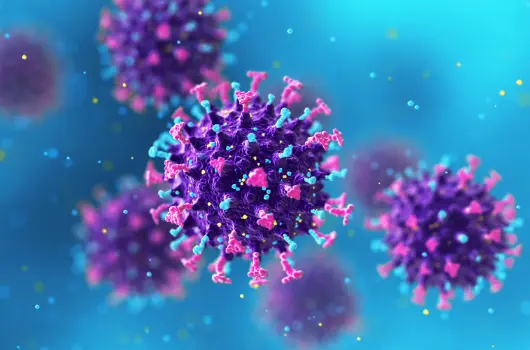Clinical Study
World MRSA Day: A Fight Against Antimicrobial Resistance

Dr. Pallavi Upadhyay • Oct 2, 2025
Background
World MRSA Day is observed every year on October 2nd– this day brings global attention and awareness to combat Methicillin-resistant Staphylococcus aureus (MRSA)., which is one of the most persistent and prominent superbugs within the healthcare sector. MRSA was first identified in 1961, and since then its incidence and prevalence have risen dramatically across the United States.1 Despite decades of awareness and prevention and control efforts, as well as treatment advancements, MRSA infections remain a significant public health concern and continue to cause severe infections, especially in hospital and clinic settings and community settings.2 Therefore MRSA infections are further distinguished into hospital-associated (HA-MRSA) infections and community-associated (CA-MRSA) infections. World MRSA Day is especially important now, as the global rise in antimicrobial resistance (AMR) underscores the awareness about superbugs like MRSA. In addition, it is crucial to not only emphasize the preventative measures and strategies but also the importance of early detection and rapid diagnostics in controlling MRSA transmission.
Transmission
Staphylococcus aureus (staph) is one of the common bacteria of our microbiota, often found on our upper respiratory tract and on the skin. About one out of every three people are long-term carriers of these bacteria. It is not pathogenic in most cases. MRSA often spreads through direct skin contact, contaminated surface contact, and invasive medical procedures and devices. Approximately only 2% of the population is a MRSA carrier (who are often asymptomatic). However, MRSA strains of Staph, due to their resistance to most common antibiotics, have the potential to cause severe (e.g., sepsis, bloodstream infections, pneumonia, etc.) and fatal outcomes.3 Anyone can get a MRSA infection or carry MRSA; however, population at risk are hospitalized patients, inpatients, nursing homes, intravenous drug users, patients with inserted medical or surgical devices, educators and students in community settings, athletes, etc.
Healthcare and Economic Burden
According to CDC MRSA is a “serious threat” and a major cause of hospital-associated infections and often linked to high morbidity, mortality, length of hospitalizations, and healthcare costs. Studies have shown that MRSA infected patients prolong their hospital stay by more than double the average length of hospitalizations for non-MRSA cases (which is 4.6 days). Noteworthy, these hospitalizations and associated inpatient treatments are lengthier and complex due to AMR and thus require higher healthcare resource utilization as compared to non-MRSA cases. According to previous surveys by CDC, more than 120,000 Staph associated blood stream infections (including both MRSA and MSSA [methicillin-susceptible S. aureus]) were noted in 2017. In the same year 20,000 MRSA-associated mortality cases were also reported within the US. The estimated cost of treatment of various multidrug-resistant bacteria, including MRSA, was approximately $4.6 billion.4,5
Testing and Treatment
Due to the asymptomatic nature of MRSA carriers and the fact that MRSA can colonize the skin or nasal passages with delayed or no symptoms, timely screening and testing play a pivotal role in preventing outbreaks. Therefore, rapid and timely diagnosis is the key to guiding treatment decisions while supporting antimicrobial stewardship. MRSA clinical diagnosis are mainly performed via conventional culture methods, molecular methods, and rapid antigen tests. 6
Traditional culture: While traditional culture is considered gold standard for MRSA detection, it is often time consuming (can take 48 hours or more to confirm results). White awaiting the test results, especially if the infection worsens, clinicians often rely on empiric broad-spectrum antibiotics, which further contributes to the spread and increase in AMR.
Rapid tests: Rapid antigen tests such as Latex agglutination and immunochromatographic tests detect bacterial penicillin-binding protein 2a (PBP2a), an enzyme encoded by mecA (one of the target resistance gene markers for MRSA). While these tests are rapid (faster than culture), they are less sensitive than PCR and can result in high number of false negatives thus leading to missed diagnosis.
Molecular PCR testing: Molecular tests like Real time Multiplex PCR can detect MRSA directly for patient swabs. And is able to detect multiple resistance gene markers from a single test. For accurate detection for MRSA, resistance markers such as mecA and mecC, with S. aureus gene markers are tested. It will also distinguish between MSSA and MRSA. Real time PCRs are highly sensitive and specific allowing rapid turnaround and timely detection, with results delivered to clinicians within hours of testing. Due to these advantages more healthcare sectors (especially hospitals) are adopting PCR-based screening for patient admissions as well as treatments.
Conclusion
While testing and treatment are crucial components of infectious disease control; prevention is the key to stay ahead of the spread. While the innovations in testing and treatment landscape are on-going, with new antibiotics, diagnostic tests, targeted therapies, it is crucial for the antimicrobial stewardship programs to continue to guide the prevention and awareness strategies.
As we observe the World MRSA Day, we emphasize that Timely testing saves lives. Accurate and prompt diagnostics enable clinicians to make faster, better-informed decisions, provide targeted patients care, and stay ahead of MRSA infections.
References
- Enright MC, Robinson DA, Randle G, Feil EJ, Grundmann H, Spratt BG. The evolutionary history of methicillin-resistant Staphylococcus aureus (MRSA). Proc Natl Acad Sci U S A. 2002 May 28;99(11):7687-92.
- CDC. Methicillin-resistant Staphylococcus aureus (MRSA). Basics
https://www.cdc.gov/mrsa/about/index.html. Accessed 10-1-25 - CDC. Clinical Overview of Methicillin-resistant Staphylococcus aureus (MRSA) in Healthcare Settings.
https://www.cdc.gov/mrsa/hcp/clinical-overview/index.html. Accessed 10-1-25. - Kourtis AP, Hatfield K, Baggs J, Mu Y, See I, Epson E, Nadle J, Kainer MA, Dumyati G, Petit S, Ray SM; Emerging Infections Program MRSA author group; Ham D, Capers C, Ewing H, Coffin N, McDonald LC, Jernigan J, Cardo D. Vital Signs: Epidemiology and Recent Trends in Methicillin-Resistant and in Methicillin-Susceptible Staphylococcus aureus Bloodstream Infections – United States. MMWR Morb Mortal Wkly Rep. 2019 Mar 8;68(9):214-219.
- Nelson RE, Hatfield KM, Wolford H, Samore MH, Scott RD, Reddy SC, Olubajo B, Paul P, Jernigan JA, Baggs J. National Estimates of Healthcare Costs Associated With Multidrug-Resistant Bacterial Infections Among Hospitalized Patients in the United States. Clin Infect Dis. 2021 Jan 29;72(Suppl 1):S17-S26.
- CDC. Laboratory Testing for Methicillin (oxacillin)-resistant Staphylococcus aureus (MRSA).
https://www.cdc.gov/mrsa/php/laboratories/index.html. Accessed 10-1-25.
References
- Enright MC, Robinson DA, Randle G, Feil EJ, Grundmann H, Spratt BG. The evolutionary history of methicillin-resistant Staphylococcus aureus (MRSA). Proc Natl Acad Sci U S A. 2002 May 28;99(11):7687-92.
- CDC. Methicillin-resistant Staphylococcus aureus (MRSA). Basics
https://www.cdc.gov/mrsa/about/index.html. Accessed 10-1-25 - CDC. Clinical Overview of Methicillin-resistant Staphylococcus aureus (MRSA) in Healthcare Settings.
https://www.cdc.gov/mrsa/hcp/clinical-overview/index.html. Accessed 10-1-25. - Kourtis AP, Hatfield K, Baggs J, Mu Y, See I, Epson E, Nadle J, Kainer MA, Dumyati G, Petit S, Ray SM; Emerging Infections Program MRSA author group; Ham D, Capers C, Ewing H, Coffin N, McDonald LC, Jernigan J, Cardo D. Vital Signs: Epidemiology and Recent Trends in Methicillin-Resistant and in Methicillin-Susceptible Staphylococcus aureus Bloodstream Infections – United States. MMWR Morb Mortal Wkly Rep. 2019 Mar 8;68(9):214-219.
- Nelson RE, Hatfield KM, Wolford H, Samore MH, Scott RD, Reddy SC, Olubajo B, Paul P, Jernigan JA, Baggs J. National Estimates of Healthcare Costs Associated With Multidrug-Resistant Bacterial Infections Among Hospitalized Patients in the United States. Clin Infect Dis. 2021 Jan 29;72(Suppl 1):S17-S26.
- CDC. Laboratory Testing for Methicillin (oxacillin)-resistant Staphylococcus aureus (MRSA).
https://www.cdc.gov/mrsa/php/laboratories/index.html. Accessed 10-1-25.
Related Articles and White papers

Dr. Pallavi Upadhyay • Oct 2, 2025
Background
World MRSA Day is observed every year on October 2nd– this day brings global attention and awareness to combat Methicillin-resistant Staphylococcus aureus (MRSA)., which is one of the most persistent and prominent superbugs within the healthcare sector. MRSA was first identified in 1961, and since then its incidence and prevalence have risen dramatically across the United States.1 Despite decades of awareness and prevention and control efforts, as well as treatment advancements, MRSA infections remain a significant public health concern and continue to cause severe infections, especially in hospital and clinic settings and community settings.2 Therefore MRSA infections are further distinguished into hospital-associated (HA-MRSA) infections and community-associated (CA-MRSA) infections. World MRSA Day is especially important now, as the global rise in antimicrobial resistance (AMR) underscores the awareness about superbugs like MRSA. In addition, it is crucial to not only emphasize the preventative measures and strategies but also the importance of early detection and rapid diagnostics in controlling MRSA transmission.
Transmission
Staphylococcus aureus (staph) is one of the common bacteria of our microbiota, often found on our upper respiratory tract and on the skin. About one out of every three people are long-term carriers of these bacteria. It is not pathogenic in most cases. MRSA often spreads through direct skin contact, contaminated surface contact, and invasive medical procedures and devices. Approximately only 2% of the population is a MRSA carrier (who are often asymptomatic). However, MRSA strains of Staph, due to their resistance to most common antibiotics, have the potential to cause severe (e.g., sepsis, bloodstream infections, pneumonia, etc.) and fatal outcomes.3 Anyone can get a MRSA infection or carry MRSA; however, population at risk are hospitalized patients, inpatients, nursing homes, intravenous drug users, patients with inserted medical or surgical devices, educators and students in community settings, athletes, etc.
Healthcare and Economic Burden
According to CDC MRSA is a “serious threat” and a major cause of hospital-associated infections and often linked to high morbidity, mortality, length of hospitalizations, and healthcare costs. Studies have shown that MRSA infected patients prolong their hospital stay by more than double the average length of hospitalizations for non-MRSA cases (which is 4.6 days). Noteworthy, these hospitalizations and associated inpatient treatments are lengthier and complex due to AMR and thus require higher healthcare resource utilization as compared to non-MRSA cases. According to previous surveys by CDC, more than 120,000 Staph associated blood stream infections (including both MRSA and MSSA [methicillin-susceptible S. aureus]) were noted in 2017. In the same year 20,000 MRSA-associated mortality cases were also reported within the US. The estimated cost of treatment of various multidrug-resistant bacteria, including MRSA, was approximately $4.6 billion.4,5
Testing and Treatment
Due to the asymptomatic nature of MRSA carriers and the fact that MRSA can colonize the skin or nasal passages with delayed or no symptoms, timely screening and testing play a pivotal role in preventing outbreaks. Therefore, rapid and timely diagnosis is the key to guiding treatment decisions while supporting antimicrobial stewardship. MRSA clinical diagnosis are mainly performed via conventional culture methods, molecular methods, and rapid antigen tests. 6
Traditional culture: While traditional culture is considered gold standard for MRSA detection, it is often time consuming (can take 48 hours or more to confirm results). White awaiting the test results, especially if the infection worsens, clinicians often rely on empiric broad-spectrum antibiotics, which further contributes to the spread and increase in AMR.
Rapid tests: Rapid antigen tests such as Latex agglutination and immunochromatographic tests detect bacterial penicillin-binding protein 2a (PBP2a), an enzyme encoded by mecA (one of the target resistance gene markers for MRSA). While these tests are rapid (faster than culture), they are less sensitive than PCR and can result in high number of false negatives thus leading to missed diagnosis.
Molecular PCR testing: Molecular tests like Real time Multiplex PCR can detect MRSA directly for patient swabs. And is able to detect multiple resistance gene markers from a single test. For accurate detection for MRSA, resistance markers such as mecA and mecC, with S. aureus gene markers are tested. It will also distinguish between MSSA and MRSA. Real time PCRs are highly sensitive and specific allowing rapid turnaround and timely detection, with results delivered to clinicians within hours of testing. Due to these advantages more healthcare sectors (especially hospitals) are adopting PCR-based screening for patient admissions as well as treatments.
Conclusion
While testing and treatment are crucial components of infectious disease control; prevention is the key to stay ahead of the spread. While the innovations in testing and treatment landscape are on-going, with new antibiotics, diagnostic tests, targeted therapies, it is crucial for the antimicrobial stewardship programs to continue to guide the prevention and awareness strategies.
As we observe the World MRSA Day, we emphasize that Timely testing saves lives. Accurate and prompt diagnostics enable clinicians to make faster, better-informed decisions, provide targeted patients care, and stay ahead of MRSA infections.
References
- Enright MC, Robinson DA, Randle G, Feil EJ, Grundmann H, Spratt BG. The evolutionary history of methicillin-resistant Staphylococcus aureus (MRSA). Proc Natl Acad Sci U S A. 2002 May 28;99(11):7687-92.
- CDC. Methicillin-resistant Staphylococcus aureus (MRSA). Basics
https://www.cdc.gov/mrsa/about/index.html. Accessed 10-1-25 - CDC. Clinical Overview of Methicillin-resistant Staphylococcus aureus (MRSA) in Healthcare Settings.
https://www.cdc.gov/mrsa/hcp/clinical-overview/index.html. Accessed 10-1-25. - Kourtis AP, Hatfield K, Baggs J, Mu Y, See I, Epson E, Nadle J, Kainer MA, Dumyati G, Petit S, Ray SM; Emerging Infections Program MRSA author group; Ham D, Capers C, Ewing H, Coffin N, McDonald LC, Jernigan J, Cardo D. Vital Signs: Epidemiology and Recent Trends in Methicillin-Resistant and in Methicillin-Susceptible Staphylococcus aureus Bloodstream Infections – United States. MMWR Morb Mortal Wkly Rep. 2019 Mar 8;68(9):214-219.
- Nelson RE, Hatfield KM, Wolford H, Samore MH, Scott RD, Reddy SC, Olubajo B, Paul P, Jernigan JA, Baggs J. National Estimates of Healthcare Costs Associated With Multidrug-Resistant Bacterial Infections Among Hospitalized Patients in the United States. Clin Infect Dis. 2021 Jan 29;72(Suppl 1):S17-S26.
- CDC. Laboratory Testing for Methicillin (oxacillin)-resistant Staphylococcus aureus (MRSA).
https://www.cdc.gov/mrsa/php/laboratories/index.html. Accessed 10-1-25.
References
- Enright MC, Robinson DA, Randle G, Feil EJ, Grundmann H, Spratt BG. The evolutionary history of methicillin-resistant Staphylococcus aureus (MRSA). Proc Natl Acad Sci U S A. 2002 May 28;99(11):7687-92.
- CDC. Methicillin-resistant Staphylococcus aureus (MRSA). Basics
https://www.cdc.gov/mrsa/about/index.html. Accessed 10-1-25 - CDC. Clinical Overview of Methicillin-resistant Staphylococcus aureus (MRSA) in Healthcare Settings.
https://www.cdc.gov/mrsa/hcp/clinical-overview/index.html. Accessed 10-1-25. - Kourtis AP, Hatfield K, Baggs J, Mu Y, See I, Epson E, Nadle J, Kainer MA, Dumyati G, Petit S, Ray SM; Emerging Infections Program MRSA author group; Ham D, Capers C, Ewing H, Coffin N, McDonald LC, Jernigan J, Cardo D. Vital Signs: Epidemiology and Recent Trends in Methicillin-Resistant and in Methicillin-Susceptible Staphylococcus aureus Bloodstream Infections – United States. MMWR Morb Mortal Wkly Rep. 2019 Mar 8;68(9):214-219.
- Nelson RE, Hatfield KM, Wolford H, Samore MH, Scott RD, Reddy SC, Olubajo B, Paul P, Jernigan JA, Baggs J. National Estimates of Healthcare Costs Associated With Multidrug-Resistant Bacterial Infections Among Hospitalized Patients in the United States. Clin Infect Dis. 2021 Jan 29;72(Suppl 1):S17-S26.
- CDC. Laboratory Testing for Methicillin (oxacillin)-resistant Staphylococcus aureus (MRSA).
https://www.cdc.gov/mrsa/php/laboratories/index.html. Accessed 10-1-25.





